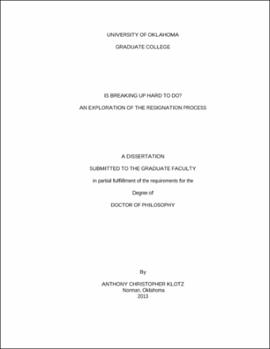| dc.contributor.advisor | Bolino, Mark C | |
| dc.creator | Klotz, Anthony | |
| dc.date.accessioned | 2019-04-27T21:30:59Z | |
| dc.date.available | 2019-04-27T21:30:59Z | |
| dc.date.issued | 2013 | |
| dc.identifier | 99259058802042 | |
| dc.identifier.uri | https://hdl.handle.net/11244/318886 | |
| dc.description.abstract | Although much is known about why employees decide to resign from their jobs, scant research has examined what occurs after employees decide to leave their jobs but before they exit their organization for the final time. In other words, the employee resignation process is not well understood. In this dissertation, a theoretical model of the resignation process is developed and two studies--one qualitative and one quantitative--are conducted to explore the manner in which workers resign from their jobs. The results indicate that resignations are emotion-filled events for departing employees and their coworkers. | |
| dc.description.abstract | Further, seven specific resignation styles emerged through inductive coding of stories of employees' resignations in Study 1, and these styles were validated in Study 2. By the book resignations are characterized by standard notice periods and resignation meetings in which employees inform their supervisors why they are leaving. Perfunctory resignations are similar, although they are more terse in nature and do not involve resigning employees providing a reason for their departure. Avoidant resignations are further still cursory, as they involve an attempt by resigning employees to evade confronting their manager with their resignation. Grateful goodbye resignations are quite positive in nature, and typically include expressions of thankfulness from resigning employees toward their employers. In the loop resignations are also positive, but unique in that during the resignation planning process, employees keep their supervisor informed of their intention to leave. On the negative side, bridge burning resignations are typified by counterproductive acts by the departing employee during resignation. Impulsive quitting resignations can also be damaging to organizations, but mainly because they involve employees leaving their jobs in an abrupt manner, with no notice, and with no planning. | |
| dc.description.abstract | A number of antecedents to, and outcomes of, each resignation style are identified in Study 2. Then, the theoretical implications of this dissertation are discussed. Finally, directions for future work, implications for practicing managers, and limitations of this dissertation are addressed. | |
| dc.format.extent | 230 pages | |
| dc.format.medium | application.pdf | |
| dc.language | en_US | |
| dc.relation.requires | Adobe Acrobat Reader | |
| dc.subject | Employees--Resignation | |
| dc.subject | Employees--Resignation--Psychological aspects | |
| dc.title | Is breaking up hard to do? An exploration of the resignation process | |
| dc.type | text | |
| dc.type | document | |
| dc.thesis.degree | Ph.D. | |
| ou.group | Michael F. Price College of Business | |
